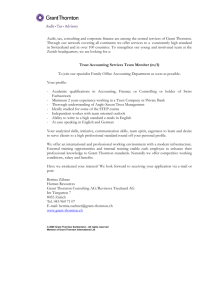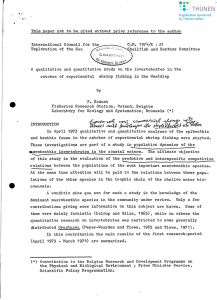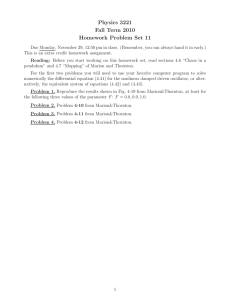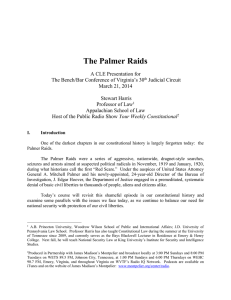v
advertisement
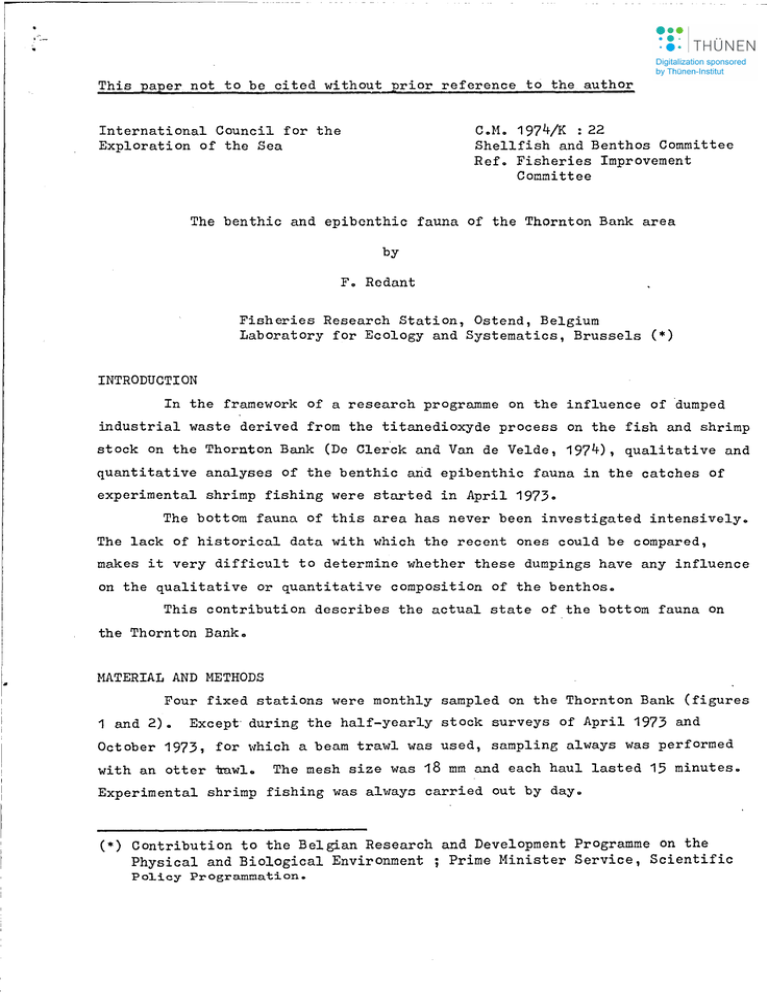
This paper not to be cited without prior reference to the author International Council for the Exploration of the Sea v CoHo 1974/K : 22 Shellfish and Benthos Committee Refo Fisheries Improvement Committee The benthic and epibcnthic fauna of the Thornton Bank area by Fo Rcdant Fisheries Research Station, Ostend, Belgium Laboratory for Ecology and Systematics, Brussels (*) INTRODUCTION In the framework of a research programme on the influence ofdumped industrial waste derived from the titanedioxyde process on the fish and shrimp stock On the Thornton Bank (De Clerck and Van de Velde, 1974), qualitative and quantitative analyses of the benthic arid epibenthic fauna in the catches of experimental shrimp fishing were started in April 19730 The bottom fauna of this area has never been investigated intensivelyo The lack of historical data with which the recent ones could be compared, makes it very difficult to determine whether these dumpings have any influence on the qualitative or quantitative composition of the benthoso This contribution describes the actual state of the bottom fauna on the Thornton Banko MATERIAL AND METHODS Four fixed stations were monthly sampled On the Thornton Bank (figures 1 and 2)0 Except· during the half-yearly stock surveys of April 1973 and October 1973, for which a beam trawl was used, sampling always Was performed with an otter Unwl o The mesh size was 18 mm and each haullasted 15 minuteso Experimental shrimp fishing was alwayo carried out by dayo (*) Contribution to the Belgian Research and Development Programme on the Physical and Biological Environment; Prime Minister Service, Scientific Policy Programmationo As soon as the catch has been discharged, the commercial und noncommercial fishes were graded. fractions with a crab sieve. lysis. After this the catch was dividcd intc two From each fraction a sampIe was taken for ana- The sampIes from the fraction remaining On the sieve (great by-catch species) had a minimal volume of 3 000 cc. From the other fraction (shrimps und small by-catch species) at least 1 000 ce was sampled. On thc Thornton Bank large catches (up to 1200 kg!hour fishing), dominated by Ophiura texturata and Asterias rubens, were recordcd very frequently. In this cases it Was quasi impossible to devide the catch with a crab sieve. Therefore the catch was nplit up into fractions of about 15 kg each. The shrimps (Pandalidae, Crangonidae, etc.) and the by-catch of only one of these fractions was separated manually. dered completely as a shrimp sampIe. The shrimp sub-fraction was consi- From the by-catch sub-fraction at least 3000 ce was taken for analysis. Analyses of the sampIes involved counting ofthe number of individuals per species and measurement of the total wet-weight of these individuals per species. The planktonic Scyphozoa and Ctenophora were not studied. For each species monthly mean densities (in kg/hour fis hing) were arilculated for the whole area. From these data yearly procentual weight con- tributions (YWC) to the average total monthly catch were derived per species. The results of these calculationn are summarized in table 1. The months during which the different species were observed are also mentioned in thc tabl RESULTS AND DISCUSSION The year1y mean weight of the catches was 174.3 kg!hour fishing. The average weight of the catchcs showed however two distinct peaks, the first one in May 1973 (261.7 kg/hour fishing) and the second one in January 1974 (321.2 kg/hour fishing). During car1y spring (February and March 1974) catches were minimal (respective1y 21.4 and 22.7 kg/hour fishing) (figure 3). The fo110wing phyla, in order of importance (YWC-va1ues), were observed (tab1e 1) : Echinodermata (YVJC Annelida (YWC Bryozoa (YWC = 71.90 %), Arthropoda (YWC = 21.70 %), = 2.76 %), Coelenterata (YWC = 1086 %), Mol1usca (nvc = 1.71 %), = .057 %), Porifera (YV1C = .005 %) and Echiurida (~VC = .004 %). 3. The most importunt species (YVIC ~.1 texturata (YWC (YV1C = 10.84 = 54.36 2.06 %), Echinocardium cordatum (YWC conchilega (YWC were (table 1) : Ophiura %), Asterias rubens (niC %), Macropipus holsatus (YWC Aphrodite aculeata (YWC %) = 1.30 = .740 %), = 15.46 = 8.74 = 2.04 %), Crangon crangon %), Pagurus bcrnhardus (YWC %), Actinia eguina %), Sepia officinlis (YWC Pectinaria koreni (YWC (nvc = .470 %), Hydrozoa (considered as a whole (YWC = .135 %), Buccinum undatuq (YWC = .120 %) = .680 ~VC = .785 (~VC = 1.61 = %), %), Lanice %), Angulus tenuis = .190 %), Abra alba and Mya truncata (YWC = .115 %). The carnivores Actinia eQuina, Tealia felina, Natica catena, Natica alderi, Sepia officinalis, Sepiola atlantica, Allotheutis subulata, Asterias rubens and Psammechinus miliaris (Barnes, 1968 ; Hardy, 1970 ; Jones, 1973 and Newell, 1970) constituted 17.9 % of the catches. The omnivores, like Aphrodite aculeata, Buccinum undatum, Crangon crangon, Crangon allmunni and Macropipus holsatus (Barnes, 1968 ; Newell, 1970 ; Plagmann, 1939 and Tait, 1968) und the more distinct detritophages Pagurus bernhardus, Ophiura texturata und Echinocardium cordatum (Barnes, 1968 ; Jones, 1973 ; Newell, 1970 and Tuit, 1968) represented 79.5 % of the catches. The remaining part of the catches (namely 2.6 %) constituted of suspension and deposit feeders. trophic level (YWC ~ .1 %) The most important representatives of this were (table 1) : Lanice conchilega, Pectinaria koreni, Abra alba, Angulus tenuis and ~ya truncata. The deficiency of the sampling method probably explains the smnllweight contributions of Polychaeta and Lamellibranchia (Redant, 1974). The macrobenthic fauna of the Thornton Bank is characterized mainly by the abundance of (nvc = 15.46 %). ~hiura texturata (YWC = 54.36 %) and Asterias rubens Up to now such a complete and almost continuous domination of the epibenthic fauna by these organisms (figure 3) along the Belgian cOast has never been describcd. This also appearcd very clearly from the results of both half-yearly stock surveys (figures 4 and 5). In April 1973 the average densities of Ophiura texturata und Asterias rubens on the 2 Thornton Bank were respectively 3851.0 ± 3288.0 gram/1000 m and 773.0 2 2 + 553.0 gram/1000 m aguinst respectively 491.0 + 1694.0 gram/1000 m and ~51.0 ± 331.0 gram/1000 m2 for the whole Belgian-coast (Thornton Bank included), 4. 2 In October 1973 these values were respectively 509.5 ± 471.5 gram/1000 m and 2 185 0 + 111.5 gram/1000 m for thc Thornton Bank versus respectively 84.8 ± 230 gram/1000 m2 und 52.5 ± 92.9 gram/1000 m2 for the whole Bclgian coast 0 0 8 (Thornton Bank included). This situation however is not arecent phcnomenon. For a long time the Thornton Bank area has the reputation to be a difficult fishing ground because of the large numbers of Echinodermata which 'dirty' the catches. The regular presence and rather high numbers of Abra alba, Ophiura texturata and Echinocardium cordatum might point to the occurence of an Abra-community on the Thornton Bank. This community is outstanding for areas with adepth between 10 and 40 m and a soft bottom composed of sand and clay (Petersen, 1924 ; Sparck, 1935 und Tait, 1968). On the Thornton Bank the repth ranges from 10 to 25 m (figure 2) und the handling of the catches is frequently hindered by large quantities of clayish mud. In Danish coastal waters the Abra-community is, among other things, characterized by large numbers of Echinodermata (Petersen, 1924). Thornton Bank this phylum constituted on average 71.9 % of On the the catches (table 1). Based on these observations the hypothesis can be postulated that the bottom fauna of the Thornton Bank forms an Abra-community. To what extent a causal relation exists betwcen the bathymetric and hydrological properties of the Thornton Bank and the occurence of an Abracommunity is not known for the moment. If there is such a relation, it is very probable that on other places with similar physical properties, the same community will be foundo Further research on the geographical distri- bution of the benthic communities along the Belgian coast is needed to prove this hypothesis. CONCLUSIONS The epibenthic macrofauna of the Thornton Bank is mainly dominated by the detritophage Ophiura texturata. Asterias rubens, Crangon crangon and Macropipus holsatus also contribute to thc composition of the epibenthic fauna but their abundunce is not so overwhelming as that of Ophiura texturata. The high densities of Ophiura tcxturata and Asterias rubens are 5. clearly characteristic for the investigated area. Taking into account the restrietions imposed by the sampling method (Redant, 1974) it can be assumed that the benthic fauna of the Thornton Bank constitutes an Abra-community. The relative high numbers of three indicator species, vize Abra alba, Ophiura texturata and Echinocardium cordatum and the 'physical aptitude of the environment (depth"range and bottom composition) could lead to this conclusion. BIBLIOGRAPHY Barnes, R.D. (1968) : Invertebrate zoology. Ed. W.B. Saunders Company, London, 743.pp. De Clerck, R. and Van de Velde,J. (1974) Biological description of a dumping area of industrial waste derived from a titane dioxyde process. ICES, 1974 O.M. E: 29. Hardy, Sir A. (1970) : The open sea. The world of plankton. Ed. Collins, London, 335 pp. Jones, D.J. (1973) : Variation in the trophic structure and species composition of some invertebrate communities in polluted kelp forests in the North Sea. Marine Biology, XX, pp. 351-365. Newell, R.C. (1970) : Biology of intertidal animals. Ed. Logos Press Limited, London, 555 pp. Petersen, C.G.J. (1924) : Abrief survey of the animal communities in Danish waters, based upon quantitative sampIes taken with a bottom sampIer. Am. Journal Sciences, 5th Series, VII, 41, pp. 343-354. Plagmann, J. (1939) : Ernährungsbiologie der Garnele (Crangon vulgaris Fabr.). Helgoländer Wiss. Meeresunters., II, 1, pp. 113-162. Redant, F. (1974) : A qualitative and quantitative study on the invertebrates in the catches of experimental shrimp fishing in the Westdiep. ICES, 1974 C.M. K Sparck, R. (1935) : On the importance of quantitative investigations of the bottom fauna in marine biology. Journal du Oonseil, X, 1, pp. 3-19. Tait, R.V. (1968) : Elements of marine ecology. Ed. Butterworths, London, 272 pp. Table 1 - Yearly procentual weight contributions (YWC) to the average total monthly catch of the ~ecies observed on the Thornton Banko , · Distribution in time (*) Specios YWC Phylum PORIFERA A MJ A 0 N D J F M 1.860 • • 0 0 · X · XXXXXXXXXX .190 X X X X X X X X X X 0005 Phylum COELENTERATA (exclo ScyphozoaJ Classid HYDROZOA - Tubularia species Laomedea species Abietinaria abietina CL.) Hydrallmania falcata (L. ) Sortularia species 0 0 X ·X X· X· X X0 X0 · · - 0 0 X 0 0 X X 0 X 0 0 0 • 0 X X X 0 0 0 0 X X X X 0 0 XXXXXX Classis ANTHOZOA 10670 X X X X X X X X X X Actinia equina Lo Toalia felina (L. ) Hotridiur.l senile (L. ) 1 .. 610 .002 .054 X X X X X X Phylum ANNELIDA 2.760 X X X X X X X X • • 0 0 0 . X 0 X X X • X X X X X X X X X Aphrodite aculeata (L. ) Lanice conchilega (PalIas) Pectinaria koreni (Halmgren) Other Annelida 1.300 0740 .680 0028 X X X X X X X X X X X X 0 0 X X X X X X X X X X X X X X X X X X X X X X · · · · · · · ·· X X · 1.710 ·0 X X 0 · ·0 X X · · 0 X X · · ·· XXXXXXXXXX Classis GASTROPODA (**) 0130 X X 0 X 0 X X 0 X 0 Natica catona (Da Costa) Natica aldori (Forbes) Crepidula fornicata (Lo) Buccinum undatum L. Dendronotus frondosus (Ascanius) 0001 0003 0005 0120 .. 001 X 0 0 0 0 0 0 0 0 • X X 0 0 0 0 X 0 0 0 0 0 0 0 0 0 0 X 0 X 0 0 X 0 X X 0 .. 0 0 Phylum ECHIURIDA 0004 Echiurus pallasi Guerin 0004 Phylum MOLLUSCA 1d Classis LAMELLIBRANCHIA (**) .750 Mytilus edulis L. Venerupis pullastra (Montagu) Spisula subtruncatu (Da costa) Spisula solida (L. ) Spisula elliptica (Brown)(?) Muctra corallina cinerea Montagu Abra alba (\vo 1:!ood) Hacoma balthica CL .. ) Angulus tenuis (Da Costa) Angulus fabula (Gmelin) Ensis arcuatus (Jeffreys) Mya truncata L. .011 0001 .. 006 .002 .001 0002 0135 .. 001 0470 1d .001 .001 .115 X X · · ·· ·X X· X X X X X X·· X X·· 0 X X X X 0 0 0 · 0 · X 0 0 0 · · · X· X · . · · ··· · · • · X 0 · 0 ·. · • 0 · ·· X 0 ·• 00 X· X· 0 0 XXXXXX • 0 X 0 • . • • • • X X X 0 · X X X • ·X 0 0 0 0 0 0 0 ·• X· • ·0 •0 ·• •0 •· ·• •· ·XX·· ···· X 0 . 7. Table 1 (continued) Distribution in time (*) Species YWO AMJAONDJFH Olassis OEPHALOPODA .835 • X X X X • • • X • Sepia officinalis L. Sepiola atlantica d'Orbigny Allotheutis subulata (L.) •785 •031 .021 • • X X X • • • X • Phylum BRYOZOA .057 • • • X X • X X X X Alcyonidium gelatinosum (L.) Flustra foliacea (L.) Other Bryozoa .056 1d .001 .001 Phylum ARTHROPODA Olassis ORUSTAOEA 21.700 Ordo Oumacea .003 • XX • 0 0 X • o 0 • 009 • • • 0 • 0 0 • ~ 0 • X • • • • X X X X • .. •••• X • XX • XXXXXXXXXX . x • · • X X X •• ...... x ... Ordo Isopoda Idotea linearis (L.) 1d .001 1d .001 Ordo Amphipoda 1d .001 • • • X X • • X • • Ordo Decapoda Pandalus montagui Leach Pandalina brevirostris (Rathke) Processa canaliculata Leach Orangon crangon (L.) Orangon allmanni Kinahan Pontophilus trispinosus (Hailstone) Pagurus bernhardus (L.)(**) Porcellana longicornis (L.) Macropipus holsatus (Fabricius) Macropodia rostrata (L.) 21.700 .009 .001 •001 10.840 .046 1d .001 2.060 1d .001 8.740 .013 XXXXXXXXXX X • • X X • .. • X • Phylum EOHINODERMAT~ o • • • • 0 X 0 • 0 X • • • X • • • • • .X • • Xo • • • • XXXXXXXXXX X X X • X X • X X X X • 0 • • X 0 0 • • XXXXXXXXXX • • • X 0 • .. XXXXXXXXXX X • X X X X X X X X 71.900 XXXXXXXXXX Olassis ASTEROIDEA 15.460 XXXXXXXXXX Asteria rubens (L.) 15.460 XXXXXXXXXX Olassis OPHIUROIDEA 54.360 X X X X X X X X X X Ophiura texturata Lamarck 54 .. 360 XXXXXXXXXX Classis ECHINOIDEA 2.070 XXXXXXXXXX Psammechinus miliaris (Gmelin) Echinocardium cordatum (Pennant) .028 2.040 X X X • • X X X • X • • XXXX • • X • The YWC-values larger than .1 were rounded off to the nearest .005 larger than 1. were rounded off to the nearest .01. 1d .001 (*) (**) : = less than .001 the values %. Months during which the different species were observed (X). and September 1973 no sampling was performed. : Weight contributions including shell. In July . , " • '''1;". J;' 'e 46* 45* 44*,* ' " 'f",'. . , \,' 47 ,.,.'.' ' , • • • • • • ,-,:, 1'" ',\ • ! . • • \' \ , '. '. " , 1 ~ O ft , .. 1- • • .- • . ' • • • • • ", . • • • • Thornton-bank sampling stations Stations half-yearly surveys -:._.:-._1:3!:'_~, "z,~~~:.,_._ ..;_.------... ,--,-~·DD' ,_'_...;. Positions~f.ih~.sampling Figura ,l.~' ~'., • ", .'" . 3'15' 3'30' stationsalong thecoast. . J . '- '. .~ "" .'., . .' .." . > • '" ,,,_._. __,,,,.. ,':' ,. ~•• ' f 239 . " 161 '. " " !,l . 166: " ; , ,136 ,I " , " 161 ,Figure 2. , " "" 141 ' ." 164 104 ... .,' ',.' 'to .. , '. '. '. : :'" .. " ' \ Positions of the sampling stations on the Thornton-bank. Depths in' decimetres. ".~- . ;; , . , ", .,' ' , ' kg/hour fishing 350 300 ~ Other Echinodermata G Ophi:-ura texturata ~ Asterias rubens ~ Anne1ida ··...... ·..... .... Cephalopoda Other groups 250 200 o o 150 0 0 0 0 0 0 a a \\ 100 a ", \\\ " \" ,\ " \ \', \, a \ \ \ \ ,,\~ , ", \ \,\\ " ,\\ \,' ~ \" , ,\ , \ , ,'\ \ \' \ ,\' \\ \ \ \,' :50 a \ '\' IV V VI VIII ' \' \\,\' \\\\\ \\'\' ,\\ ,\ " '\' \' \\ \ ' \,,~ \' \ \ \\\\ a a a \\~~ ~\\ \\\~\ \ \\ \ , \\' \ \\ \\\\ \\\ X , XI XII 1973 I II III 1974 Figura 3. Evolution and compoaition of the catches on the Thornton-bank. Average densities bc d .cC0. = 1694.0 s tb , 0 = 491.5 d = 3851.0 s = 3288.0 • • . . • ' •• • • .' • , • ' • • • 0-5 6-20 21-100 • . .. • • e 0 101-500 501-2000 Period 24.04.73 - 03.05.73 2'30' , Average densities :' er:: 84.8 tb : d . s = 230~8 = 509.5 s 471.5 • o • "00 = 3'30' e. • • • c. 0 3'15' 3' 00' 2'45' b'c : 2001-10,000 0 • • • • • • • • • • • • 0 21-100 0 101-500 0 501-2000 Period 02.10.73 - 16.10.73 , 0 .. 5 o"ZO . 2 ' 0 2001-10,0000 Distribution and density(gram/1000 m ) cf Ophiura texturata Lamarck. Figure 4. , I' ,I '" Average densitics .~ on n°cS? 151.0 :: 331.0 d :: '773.0 s :: 553.0 d bc :: s tb Cf '\ \J I ,,-,,0 0 o o o 00 o o o o 0° 0 z • o o o ~5 0 Q 6-20 o 101-500 Period 501- 2000 24.04.73 - 03.05.73 2'30' 0 21-100 3'CO' 2'45' 0 0 j '15' 3'30' Average densities tb 00 0 ,', 52.5 s :: 92.9 d :: 185.0 s :: 111.5' bc d '.. :: 00 • o 00 o o Q' °0 0 o o· o o • o 0 • Lu o • 5 0 6-20 0 21-100 0 ~ o ~ I Period 02.10.73 - 16.10.73 101-500 501- 2000 0 2 Distribution'and density (srao!1000,m ) of Asterias rubens (L.) Figure 5. 0'
